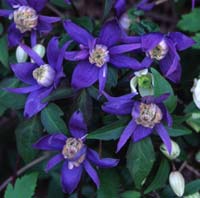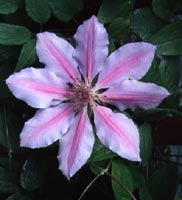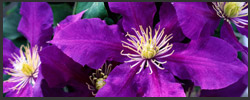YOU ARE HERE Garden Answers > Clematis pruning
 Pruning clematis
Pruning clematis
- Pruning early-flowering species clematis
- Pruning early-flowering, large-flowered clematis hybrids
- Pruning late-flowering, large-flowered clematis hybrids & species
- Pruning herbaceous clematis
- After pruning
Pruning is one garden job that confuses many gardeners. Pruning clematis - how and when to prune clematis - is one pruning job that is seen as a gardening problem.
You don't HAVE to prune clematis. Pruning can be restricted to:
- Plants that are out-growing their allotted space
- Plants that produce flowers too high up on the plant to enjoy them
Pruning in the latter case can even be avoided by retraining and tying shoots lower down on the support - say just above ground level. These shoots produce their flowers much lower down.
Training shoots horizontally not only keeps the flowers within eye level, but provides better coverage of the support, and the reduced flow of sap encourages even more flowers.
Clematis can be divided into three pruning groups, depending on when they flower.
How to prune clematis
Group 1
Early spring and winter-flowering species clematis (such as Clematis montana, Clematis macropetala, Clematis alpina and Clematis cirrhosa)
 |
These plants flower on growth produced the previous year and, if pruning is needed, are just given a light pruning to remove spent flowers immediately after flowering. Tall plants can be pruned harder if necessary. Old, woody plants can be pruned very hard - down to a couple of feet if necessary, preferably to just above some strong, healthy growth - after flowering to remove lots of the old, non-flowering growth. Plants may take a year or so to fully recover and start flowering properly again. Old plants may not recover. Clematis macropetala |
Group 2
Large-flowered hybrids that start flowering in May/June
 |
These cultivars can be cut back fairly hard - say to between 90cm to 1.2m (3-4ft) high - to just above a bud/pair of buds. Start pruning at the top of the plant and work your way down. Pruning is carried out at the end of February/early March. Clematis 'Nelly Moser' |
Group 3
Large-flowered hybrids that start flowering in June/July and C. texensis, C. tangutica and C. orientalis species
 |
These can be cut back very hard - say to 23-45cm (9-18in) high - again just above a bud/pair of buds - removing nearly all of the previous year's growth. Start pruning at the bottom of the plant. Pruning is carried out at the end of February/early March. Clematis 'Jackmanii' |
Although some years can encourage a lot of early growth on clematis, don't be tempted to prune Group 2 and Group 3 cultivars any earlier, as frosts can still kill this early growth leaving none to grow away on hard-pruned plants.
If you want to retain some tall growth on these plants to cover the supporting structure, you could cut down just half the shoots as described above. This will give slightly earlier but higher flowers on the un-pruned growth. The pruned shoots will flower a little later and produce flowers lower down the plant. This gives a better and slightly longer display.
Herbaceous clematis
You should prune herbaceous clematis, such as C. heracleifolia, C. integrifolia and C. recta, to almost ground level in late autumn or early spring.
After pruning
As with any plants, pruning should be followed by a good feed with a granular fertiliser. Rose food is excellent for this and this is what I use.
If you want to know more, or if you've got a gardening problem you need help with, then send an e-mail to: info@gardenforumhorticulture.co.uk


